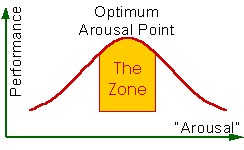|
|
|
|
| Why it matters |
Most models of arousal/performance
relationships predict an optimum arousal level, a 'zone', where performance
is highest. The one above is typical; with no pressure, nobody performs
at all; with too much, we crash.
Sports psychologists have spent a lot of effort working out how to
get into the Zone more reliably. It's not sorted yet, because people
are so different and there are so many different factors to consider.
But there is a pretty consistent general approach,
and a set of tools that go with it. |
|
|
|
| Reducing arousal |
Most problems revolve round anxiety control
and arousal reduction.
Tools for reducing arousal levels and controlling anxiety:
|
| |
 Relaxation Relaxation
 Anxiety
control Anxiety
control |
|
|
|
|
In archery, with little physical exertion
and aggression, you can sometimes need 'pumping up' for
performance.
Tools for raising arousal levels: |
| |
 Raising
arousal level Raising
arousal level |
|
|
| |
|
|
| The steps below represent a typical approach to anxiety and arousal
control for competition. |
 |
Find out where your
optimum arousal level is. |
You
may already have a feel for this. If not, keep records of your
mood immediately before competitions and your score afterwards.
There are some well-established tests for mood state, but a
simple scoring scheme will give you a fair idea. |
 |
Develop relaxation and warm-up skills
to adjust arousal level. |
Check out the  Relaxation, Relaxation,
 Anxiety
control and Anxiety
control and  raising
arousal pages for a bucketful of useful techniques to check
out and apply. raising
arousal pages for a bucketful of useful techniques to check
out and apply. |
 |
Work out a 'mental warm-up' for competition
that gets you into the right state of mind. |
Check out the  mental
warm-up page. mental
warm-up page. |
 |
Adapt your warm-up routine
if necessary according to circumstances. |
Once
you have a general warm-up routine, you can modify it to suit
your actual mood; for example, by emphasising or adding relaxation
or motivation elements of the routine. |
|
